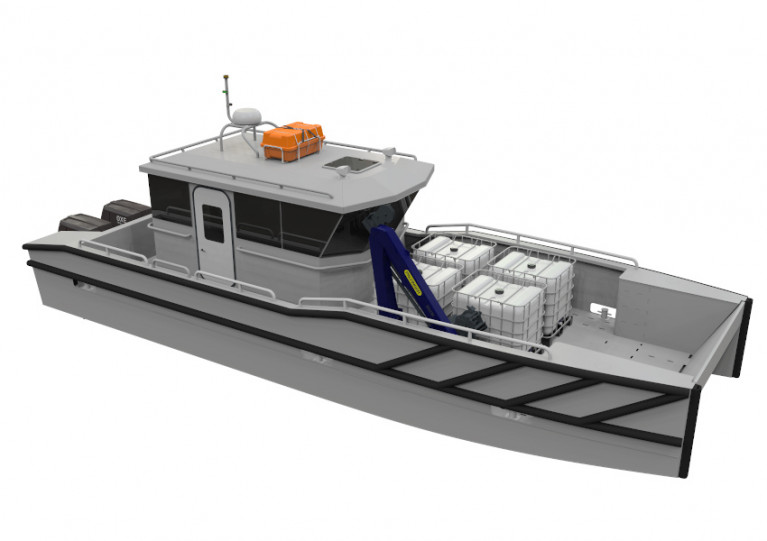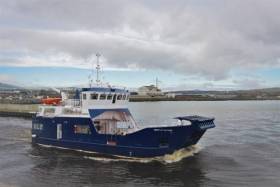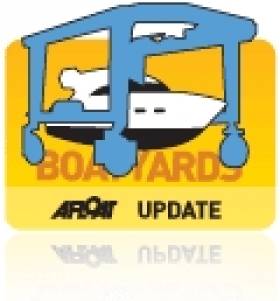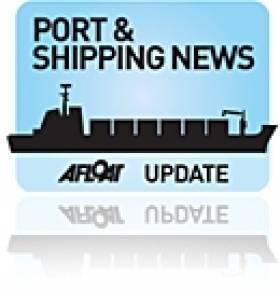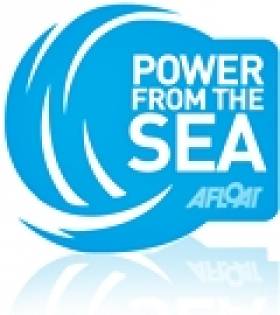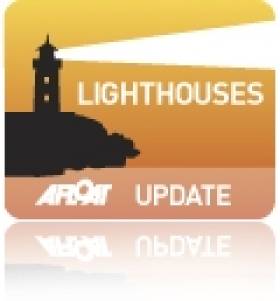Displaying items by tag: Arklow Marine Services
Chartwell Marine Unveils New Landing Craft to Support Irish Offshore Energy Operations
British boatbuilder Chartwell Marine has unveiled its bespoke 12m landing craft commissioned by a leading Dublin boat charter company to support large-scale offshore energy projects.
The aluminium vessel for Irish Commercial Charter Boats (ICCB) will be constructed at Arklow Marine Services, with a view to hitting the water this summer.
And according to Chartwell Marine, it sets the stage “for a rapid build-out of the Irish offshore fleet in the next few years, as new large-scale energy projects come online”.
The company says the “market-first” craft has been designed “to meet ICCB’s expanding operational requirements, including surveying, assisting with cable landing and transporting supplies and personnel to near-shore offshore installations”.
It will be powered by two OXE diesel outboard engines, plus room for a spare onboard, with the flexibility to replace these with electric outboard motors in future.
And its shallow draft, allowing it to operate in depts of just 0.8 metres, will ensure “maximum versatility in the shallow waters around the East Irish coast”.
ICCB director Eoin Grimes said: “We’re excited to help drive the development of the next generation of Irish offshore support vessels.
“Chartwell Marine’s vessel offers us unparalleled manoeuvrability and versatility, especially in the shallow waters around Ireland, which will be vital as we continue to diversify our offering to the offshore energy market.”
New 'Heart of the Sea' Salmon Harvesting Work-Boat Takes to the Water
#Newbuild - A mobile crane has lowered a new workboat into the River Avoca in Arklow this week for Ireland's largest producer of farmed Atlantic salmon, writes Jehan Ashmore.
The newbuild constructed by Arklow Marine Services is the Croi na Farraige (Heart of the Sea), a 17.5m salmon farm harvesting vessel for clients Marine Harvest Ireland. Staff from the company were invited to name the new vessel though a competition.
Croi na Farraige was transferred from the AMS building hall to the nearby North Quay of the Co. Wicklow port. It was from the quayside that the flat bottomed hull craft first made contact with the water.
The newbuild is equipped with a hydraulic crane mounted on the bow and a deckhouse is located aft. It is from the stern that can be seen in the above photo that the vessel has a twin rudder and propellor arrangement. Also clearly to be seen is that the vessel's port of registry is Sligo.
Marine Harvest have several sea farms along the western seaboard. They are located on Lough Swilly, Mulroy Bay, Inver Bay, Clew Bay, Kenmare Bay and Bantry Bay. All of the fish from these farms are packed at the firms Co. Donegal factory in Rinmore on the Fanad peninsula.
Croi na Farraige, will be used to support those sea-farms in Donegal waters from where Marine Harvest was founded by Irish investors in 1979.
MHI is part of the Marine Harvest Group with heaquarters in Norway, and is one of the world's leading seafood companies and the world's largest producer of Atlantic salmon. The global aquaculture operation employs 12,500 throughout 24 countries and servicing 70 markets.
#EntersService – The new custom-built car ferry Spirit of Rathlin has finally entered service with a first scheduled sailing today on the Rathlin Island link with Ballycastle on the Antrim mainland, writes Jehan Ashmore.
Spirit of Rathlin built by Arklow Marine Services at cost of £2.8m entered the route which caters for 6 vehicles and 140 passengers. The 28m long newbuild directly replaced the ageing Canna which performed a final crossing last night concluding two decades of loyal service.
The introduction of Spirit of Rathlin is based on a 10 year contract to Rathlin Ferry Co. This was awared to the ferry company following a tender process from Northern Ireland’s Department for Infrastructure (dfi) that funded the ferry.
Spirit of Rathlin is a boost to islanders and tourists alike as the new ferry offers better accommodation in the form of a saloon lounge area (seating 42) on the main deck. On the above decks 1 and 2, there is additional seating outside to take in the scenic views across Rathlin Sound.
In terms of freight he ‘Spirit’ will have the ability to convey an articulated truck and the newcomer will not be alone as the is also the passenger-only fastcraft Rathlin Express.
Prior to today’s opening, as previously reported on Afloat the new ferry had undergone further works at Mooney Boats, Killybegs. The work involved the use of the Donegal yard's syncro-lift.
In recent months, essential crew training was carried out before the Spirit of Rathlin was permitted a MCA certification. Also improvements to berthing infrastructure had to be completed in Ballycastle Harbour to accommodate the new ferry.
#FerryCompleted - Spirit of Rathlin the new £2.8m car and passenger ferry is to be operated under a new ten year contract awarded to Rathlin Island Ferry Ltd, writes Jehan Ashmore.
The newbuild built by Arklow Marine Services undertook sea trials last year and is to replace an ageing ‘Island’ class ferry the Canna on the Ballycastle-Rathlin service. This former CalMac ferry dating to the 1970's has served alongside the passenger only catamaran Rathlin Express, also constructed at the Co. Wicklow shipyard owned by the Tyrrell family.
Spirit of Rathlin was contracted to AMS by Northern Ireland’s Infrastructure department, whose Minister Chris Hazzard welcomed this week the completion of the ferry.
The Minister said: “I am delighted to announce completion of the new car and passenger ferry for Rathlin Island. This is excellent news for the people of Rathlin and particularly for those who use this essential service to go about their daily business.
"The ‘Spirit of Rathlin’ ferry will ensure that passenger and vehicle services can continue to be provided on this important lifeline route between Rathlin Island and Ballycastle. This new ferry has been designed to modern standards and includes the latest technology for the service it will operate.”
Spirit of Rathlin will come into service once the new £1m harbour to accommodate the newbuild is completed. Following that stage a Passenger Certificate is to be obtained from the Maritime and Coastguard Agency (MCA) to enable the ferry to begin operating.
So what does the Spirit of Rathlin bring to the Co. Antrim route, firstly the stern-only loading vehicle ferry includes a modern passenger lounge. During good weather there is an upper passenger deck to take in this most scenic route of the north coast.
Arklow Marine to Launch New Car Ferry for Rathlin Island Route
#NewBuild - Arklow Marine Services are to launch a new car ferry which is to serve Rathlin Island off the Antrim coast, writes Jehan Ashmore.
Northern Ireland’s Department for Infrastructure (DFI) awarded the contract for the 6 vehicle /140 passenger ferry to the Co. Wicklow based boatbuilder, headed by Billy and John Tyrell.
Responding to Afloat.ie a DFI spokesperson said the Department is still in the process of evaluating the bids for tenderers to operate the new Rathlin ferry.
Following delivery of the new ferry to be named Spirit of Rathlin, the newbuild is to undertake trials for three to four weeks. In addition crew familiarisation is to take place, after which the vessel is expected to come into operation.
The Ballycastle-Rathlin route is operated by the Rathlin Island Ferry Ltd which currently uses three vessels, Canna, Rathlin Express and St. Sorney.
Canna is an ageing ‘Island’ class car ferry, which dates to 1976, having originally served the Scottish West Isles for CalMac. The 40 year-old ferry bow-loading vessel has the same vehicle and passenger capacity of the newbuild.
In 1997, Canna was transferred to Rathlin with CalMac contracted to run the service. In the following year she was chartered by the Scottish publically funded ferry company to Rathlin Island Ferry Ltd who took over the operation of the service.
In 2009 the passenger-only, Rathlin Express, an aluminium catamaran craft, also built by Arklow Marine Services entered the route.
This leaves the third vessel, St. Sorney, also passenger-only and which serves as a reserve boat. The 40ft ‘Lochin’ cruiser was built by Ryan & Roberts of Limerick.
Arklow Marine Services Launch Vessel for Scottish Client
#ArklowMarine – Arklow Marine Services have completed Sally Ann, a newbuild which has been delivered to her owners Scottish Sea Farms.
Sally Ann is powered by twin Doosan V158TIH main engines and designed by consultant naval architects AG Salmon as a multi-role vessel. She is to be used on the west coast of Scotland where Scottish Sea Farms have all their sites.
The vessel is 22.8m in length with an 8m beam and a lightship displacement of 120 tonnes. She has a service speed of 9 knots with a maximum speed of 10.5 knots. For more details, the Maritime Journal has a report here.
Arklow Boat Builder's Offshore Wind Business Securing Its Future
#Shipbuilding - Arklow Marine Services recently celebrated the completion of its third service vessel for the offshore wind farm sector in the shape of the Gardian 18.
And as the company's director Billy Tyrrell tells The Irish Times, it's the latest fruit of an important decision the fourth-generation boat builder made some time ago to adapt for the future.
"About five years ago we realised that we had to change tack," he says. "We had been looking after the fishing industry but the decline meant that industry was gone from us."
The solution for Arklow Marine Services was a redirection towards the growing offshore energy sector in the UK - and according to Tyrrell it now accounts for up to 50% of their turnover.
The Gardian 18 itself represents a €2.3 million order, the third for offshore specialist Gardine's subsidiary Alicat following two successful launches in early 2012.
Tyrrell says adapting to the industry's requirements has not been difficult, noting that "the basic principles are the same; we're just applying [our craft] to different markets."
But the firm hasn't abandoned its traditional shipbuilding business, and is even continuing to take on land-based fit-outs and maintenance on the side. As Tyrrell says, "you need the big contracts but you need the small stuff too."
The Irish Times has much more on this story HERE.
Irish Shipyard Wins Big in UK Offshore Wind Sector
#newships – Arklow Marine Services, the shipbuilding yard owned and managed by the Tyrrell family, is celebrating the successful completion of a €2.3m order with the launch of a vessel for use in the development of UK offshore wind farms. The Gardian 18, is the third such vessel which the Arklow business has delivered to Alicat a subsidiary of UK offshore wind specialists Gardline , in the last three years.
The Gardian 18 can carry 12 personnel & 2 crew and is fitted with twin MAN main engines each developing 1000 BHP and is coupled to Rolls Royce water jets that will give the vessel a sprint speed of 30 knots and a service speed 25 knots. Gardian 18 has a range of 800 nautical miles.
Arklow Marine Services carries on the proud tradition of shipbuilding in Arklow having commenced trading in 1864 and celebrates 150 years in existence next year in 2014. The Tyrrell name remains synonymous with shipbuilding in Arklow and today the company is led by Directors Billy – Naval Architect & John – Marine Engineer. The company currently employs 30 local people and supports employment with other contractors in the region.
The Gardian 18 was built on-schedule and on-budget over a 30 week period. Among the skills involved in the construction were design and draftsmanship, machining, aluminium fabrication, welding, hydraulic engineering, mechanical engineering, electrical engineering pipe fitting, engine alignment, plumbing, glazing, carpentry, painting, sign writing and cranage. The management of the company would like to acknowledge and thank their excellent workforce whose expertise and strong work ethic which allows them to deliver quality vessels on time every time.
Arklow Marine Services Director Billy Tyrell spoke of the potential for the company to benefit from the development of renewables on both sides of the Irish Sea;
"Over the last number of years Arklow Marine Services has developed a reputation for delivering high performance vessels for the renewable industry. Offshore wind is a rapidly growing sector in the UK and we are well positioned to take advantage of that market. Hopefully, we will see similar development in Irish offshore projects. This can deliver jobs for coastal towns like Arklow and businesses like Arklow Marine Services. We are delighted to continue our partnership with Gardline and look forward to working more closely with them as their business grows."
The United Kingdom is in the process of developing 33 GW of offshore wind energy over the next decade. That is an amount seven times the total electricity demand in Ireland. There is a further 2.5 GW of offshore wind in development on the Irish Side of the Irish Sea. The National Offshore Wind Association has estimated that a supply chain of up to €60bn exists in the Irish Sea Zone.
Brian Britton of the National Offshore Wind Association welcomed this latest contract win for Arklow Marine Services;
Arklow Marine Services is an example of how quality Irish companies can compete for supply chain opportunities that offshore wind development presents. They have already won a significant position in the UK market. We believe that with the development of Irish projects, companies like Arklow Marine Services will generate a significant employment boost for the Irish economy.
Gardline specialise in supporting the deployment, operation and maintenance of offshore wind farms. The Gardian 18 will enter service in late November. This vessel will principally be used to deliver service personnel to the offshore wind farms. The nature and design of offshore turbines necessitates vessels of high specification and unique design suitable for servicing them.
Gardline Managing Director, Steve Thacker explained the reason for partnering with Arklow Marine;
We are delighted to partner once more with Arklow Marine Services for the development of another bespoke vessel for our fleet. We operate in the toughest of conditions. Our customers demand reliability from us and we require vessels which deliver that and which meet the highest standards of safety. The Gardian 18 is the latest in a series of vessels from Arklow for Alicat and is currently for sale, which is an advantage of not having to fund the vessel whilst under construction and is ready to go straight to work
Arklow Marine Launch 19m Offshore Wind-Farm Service Vessel
#WFSVlaunch- A third offshore Wind-Farm Service Vessel (WFSV) was launched in late September from Arklow Marine Services boatyard.
The 19m newbuild vessel is the first of a new design which is intended for the upcoming Round 3 offshore sites for the Renewable Offshore Industry in the U.K.
The WFSV has an overall length (LOA) of 20.75m and a beam of 7.36m. The vessel is powered by twin MAN main engines. Each engine develops 1,000 BHP and are coupled to twin Rolls Royce FF550 water jets.
A sprint speed of 30 knots and a service speed of 25 knots. Sea-trials were scheduled prior to the WFSV's introduction into operating at one of the UK's burgeoning new offshore wind -farm sites.
Lighthouse Tender Carries Out Trial Runs Since Modifications
#LighthouseTender- ILV Granuaile the aids to navigation tender is carrying out another trial run of systems at sea today in Dublin Bay and off Greystones, writes Jehan Ashmore.
As previously reported on Afloat.ie, the Commissioners of Irish Lights 79m tender had undergone work that has involved the installation of a new radar mast, calorifier units and modifications to the bridge.
Arklow Marine Services carried out the work while the vessel was berthed in the port along Sir John Rogersons Quay.
The 2,625 tonnes buoy-handling vessel is expected to return to her homeport of Dun Laoghaire Harbour tonight.



























